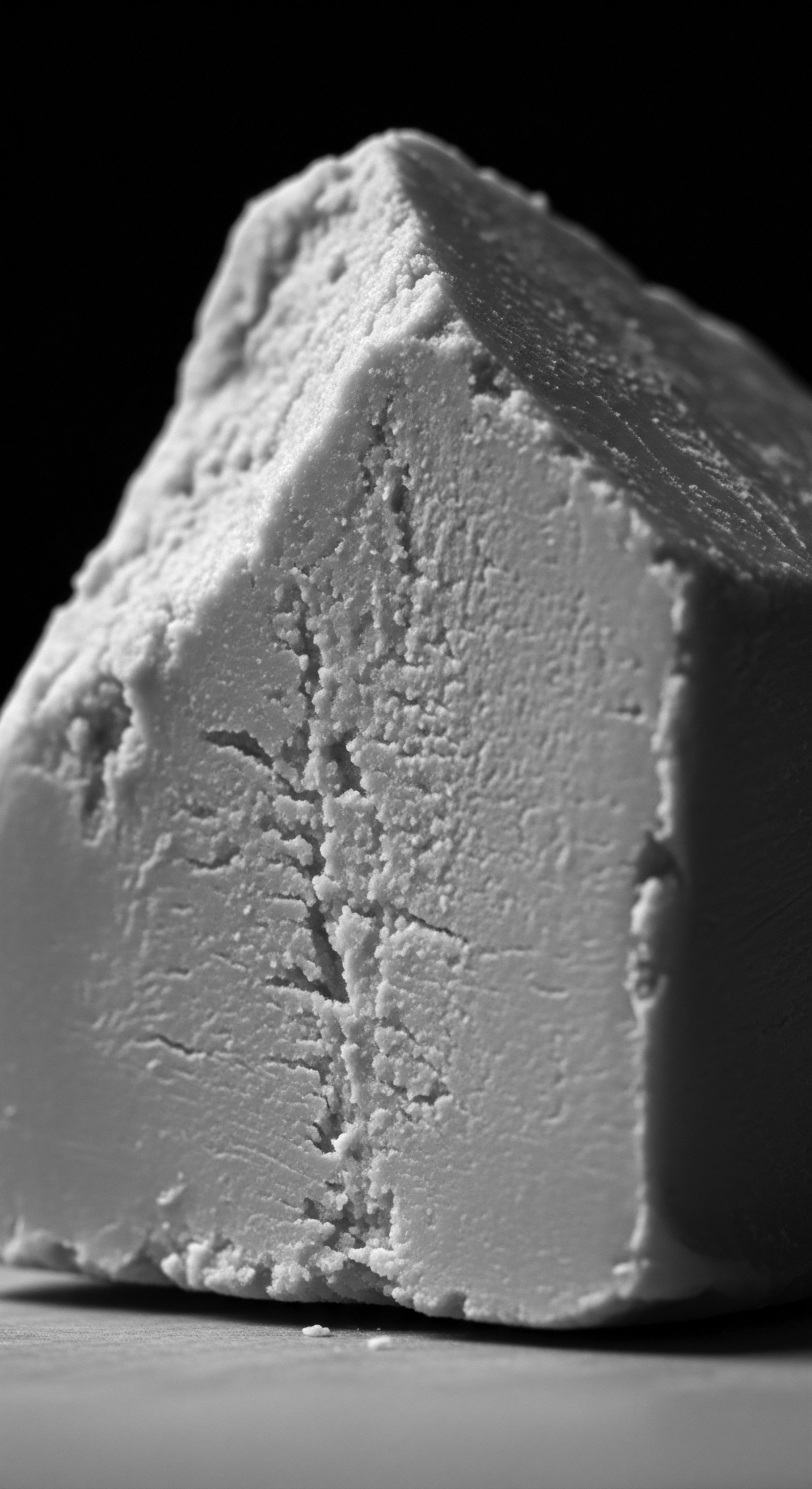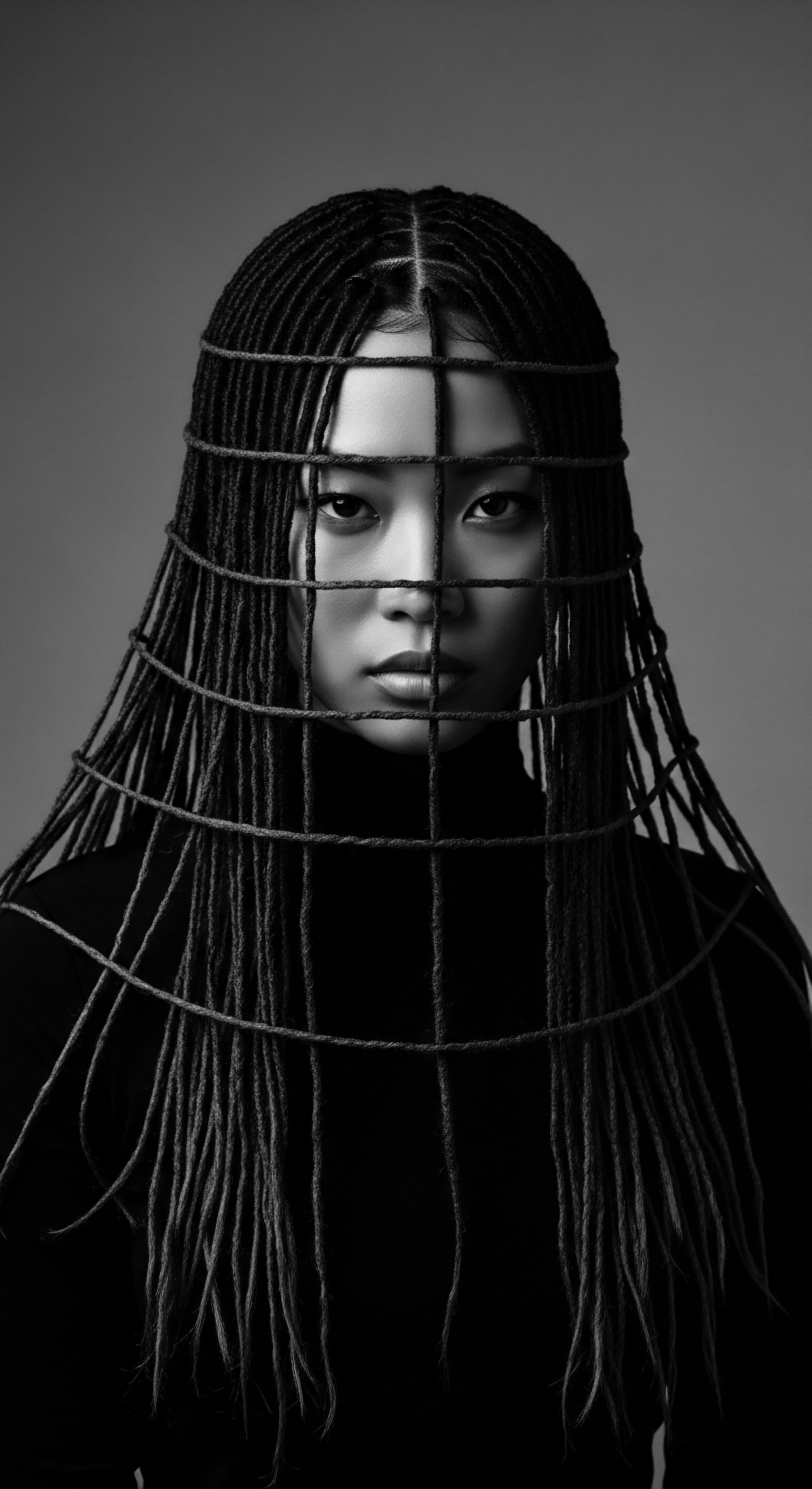
Fundamentals
The very strands that crown our heads, particularly those with the glorious coil and curl of textured hair, hold stories far deeper than mere appearance suggests. They are living archives, imbued with ancestral memory and the whispers of generations. Within this profound understanding, we approach the notion of Endocrine Disruptors Hair not as a simple scientific term, but as a concept that calls us to contemplate the delicate balance between our inner physiological landscape and the external world. At its simplest, it describes the ways certain external chemical agents, often found in everyday products, can interfere with the body’s hormonal system, subsequently influencing the health and vitality of our hair.
Our bodies operate through an exquisite network of chemical messengers, the endocrine system, orchestrating everything from growth to mood, and yes, even the intricate cycles of hair. When foreign substances, termed Endocrine-Disrupting Chemicals (EDCs), mimic, block, or otherwise disturb these natural messengers, a ripple effect can begin. For hair, this might translate to changes in its growth patterns, its inherent strength, or even its ability to retain moisture – alterations that can feel particularly poignant for those whose hair traditions are deeply intertwined with notions of health, length, and communal identity.
Endocrine Disruptors Hair unveils the subtle yet significant influence of environmental chemicals on the very fabric of our textured tresses, urging a deeper understanding of ancestral care and modern well-being.
Historically, communities with textured hair understood hair health as an extension of holistic well-being, drawing from the earth’s bounty for nourishment and protection. Their methods, passed down through oral traditions and hands-on practice, were often intuitively aligned with principles of minimizing harm and maximizing natural vitality. They did not speak of ‘endocrine disruptors,’ certainly, yet their careful selection of herbs, oils, and clays for cleansing, conditioning, and styling served as a natural barrier against unseen harms. This ancient wisdom, born from keen observation and a deep reverence for nature, offers a poignant contrast to our modern predicament, where countless synthetic compounds permeate our environments.

The Unseen Currents ❉ Initial Interactions with Hair
The initial contact of these chemicals with hair is often through the scalp, a highly permeable area of the skin. Follicles, those tiny organs responsible for each individual strand, are not isolated entities; they are complex biological structures responsive to hormonal signals. When EDCs gain entry, they possess the capacity to influence these signals, potentially altering the follicular environment.
This interference can manifest in subtle ways, perhaps slowing the rate of growth, impacting the thickness of a strand, or even disrupting the natural shedding and regrowth cycles. For hair that already navigates the unique challenges of curl patterns, such as dryness or breakage, these subtle interferences can amplify existing vulnerabilities.
- Phthalates ❉ These compounds, often found in fragrances, can alter hormone levels, possibly influencing hair growth phases.
- Parabens ❉ Employed as preservatives, they can mimic estrogen, with potential implications for hair follicle activity and overall scalp balance.
- Heavy Metals ❉ Sometimes present as contaminants, these can lead to hair loss or damage by interfering with cellular processes vital for hair production.
Consider the daily rituals of hair care, from cleansing to styling. Each product chosen, each ingredient absorbed, contributes to a cumulative exposure. For textured hair, which often requires a more extensive product regimen to maintain its unique moisture and curl definition, the potential for exposure to EDCs can be a quiet, persistent undercurrent. The ancestral practices, in their elegant simplicity, often circumvented this exposure by relying on ingredients that were either food-grade or derived directly from nature, carrying the wisdom of generations in their efficacy.

A Legacy of Care ❉ Ancestral Insights
Our ancestors, in their profound connection to the land, utilized ingredients like shea butter, various plant oils, and herbal infusions, intuitively understanding their fortifying and protective properties. Their knowledge, transmitted across generations, was a living science, refined through trial and observation. These practices, often tied to communal grooming rituals, ensured not only the physical health of the hair but also its spiritual and cultural resonance. The shift towards industrial products, often laden with synthetic compounds, marks a departure from this heritage of mindful, natural care, posing new questions about the long-term well-being of our textured strands.

Intermediate
Stepping beyond the foundational understanding, the concept of Endocrine Disruptors Hair deepens, calling for a more nuanced appreciation of how these chemical agents interact with the delicate ecosystem of the scalp and the intricate life cycle of textured hair. This intermediate exploration considers the pathways of exposure, the specific biological mechanisms at play, and the historical context of how these exposures have disproportionately affected communities with a rich heritage of textured hair, often through the very products designed for their unique needs.
The skin, including the scalp, serves as a primary route for chemical absorption. Unlike the protective layers of straighter hair, the denser, often more porous nature of coiled and kinky hair, coupled with frequent manipulation and product application, can create a unique micro-environment. This environment might potentially facilitate greater dermal exposure to substances present in hair care formulations. The scalp, rich in blood vessels and hair follicles, becomes a direct conduit for EDCs to enter the bloodstream, allowing them to circulate throughout the body and interfere with hormonal signaling far beyond the localized area of application.
The intermediate understanding of Endocrine Disruptors Hair reveals how the unique physiological and cultural aspects of textured hair can amplify the effects of environmental chemicals.

Chemical Whispers ❉ The Biological Impact
Endocrine disruptors exert their influence by mimicking natural hormones, blocking hormone receptors, altering hormone synthesis or metabolism, or affecting hormone transport. For hair, this interference can be particularly impactful given the hair follicle’s profound sensitivity to hormonal fluctuations. Androgens, estrogens, thyroid hormones, and even stress hormones like cortisol, all play critical roles in regulating the hair growth cycle (anagen, catagen, telogen phases), follicular size, and sebum production.
- Follicular Dysregulation ❉ EDCs can disrupt the precise timing of hair growth phases, leading to premature shedding or inhibited growth.
- Sebum Alterations ❉ Interference with sebaceous gland function can result in an overly oily or excessively dry scalp, impacting hair hydration and health.
- Inflammatory Responses ❉ Some EDCs may trigger inflammatory pathways within the scalp, potentially damaging follicles and contributing to conditions like folliculitis or dermatitis, which are already prevalent in some textured hair types.
The persistent application of products containing EDCs over years, even decades, creates a cumulative burden. This is not a single event, but a slow, persistent alteration of the body’s internal messaging system. For communities whose hair traditions often involve frequent and extensive product use – from detanglers and conditioners to styling creams and relaxers – this cumulative exposure becomes a significant concern. The pursuit of certain aesthetic standards, often influenced by societal pressures, has historically driven the widespread use of products that, unknowingly, contained these chemical interlopers.

Echoes of Ancestry ❉ Traditional Care Vs. Modern Challenges
Ancestral hair care practices, honed over millennia, prioritized scalp health and hair vitality through natural means. These traditions often involved:
- Herbal Infusions ❉ Decoctions from plants like aloe vera, fenugreek, or hibiscus were used for their conditioning, strengthening, and cleansing properties, free from synthetic additives.
- Natural Oils ❉ Shea butter, coconut oil, and castor oil, revered for their moisturizing and protective qualities, formed the foundation of many traditional regimens, sealing in moisture without introducing harmful compounds.
- Clay Washes ❉ Bentonite or rhassoul clay offered gentle cleansing, drawing out impurities from the scalp without stripping natural oils or depositing synthetic residues.
The introduction of industrial-scale hair products, particularly during and after the colonial era, marked a significant departure. Products promising ‘manageability’ or ‘straightness’ often contained harsh chemicals, including lye-based relaxers and early synthetic formulations. While these might not have been recognized as ‘endocrine disruptors’ at the time, they represented a shift towards chemically intensive solutions, laying a historical groundwork for current concerns. The economic pressures and societal norms that encouraged the adoption of these products further complicate the narrative, highlighting a complex interplay of cultural adaptation, economic access, and evolving understandings of beauty.
| Traditional Practice Using plant-based oils (e.g. shea, coconut) for moisture and scalp massage. |
| Modern Scientific Link to Hair Health (post-EDC Awareness) These oils provide lipids and antioxidants, supporting scalp barrier function and potentially mitigating oxidative stress, thereby offering a natural defense against environmental aggressors. |
| Traditional Practice Cleansing with natural clays or saponifying plants. |
| Modern Scientific Link to Hair Health (post-EDC Awareness) These methods gently remove impurities without harsh detergents that can disrupt the scalp's microbiome or introduce synthetic EDCs. |
| Traditional Practice Hair braiding and protective styling. |
| Modern Scientific Link to Hair Health (post-EDC Awareness) Reduces physical manipulation and exposure to external pollutants, preserving the hair's integrity and minimizing the need for daily product application. |
| Traditional Practice The enduring legacy of ancestral hair care offers profound insights into fostering resilient hair health, often by intuitively avoiding the very chemical exposures now identified as endocrine disruptors. |
Understanding Endocrine Disruptors Hair at this level requires acknowledging the historical journey of textured hair care, from the intentional, natural practices of our forebears to the complex landscape of contemporary products. It compels us to consider how past choices, influenced by prevailing societal norms and limited scientific knowledge, have shaped the current challenges faced by communities dedicated to preserving the health and heritage of their hair.

Academic
The academic delineation of Endocrine Disruptors Hair posits it as a multifaceted phenomenon, describing the intricate interplay between exogenous chemical agents and the complex biological, physiological, and cultural dynamics governing the health and presentation of textured hair. This concept extends beyond a mere biochemical interaction, encompassing the historical trajectories of exposure, the disproportionate burden on specific communities, and the subsequent implications for individual well-being and collective identity. It represents a critical lens through which to examine environmental justice, public health, and the enduring legacy of hair traditions within the Black and mixed-race diaspora.
At its core, the definition of Endocrine Disruptors Hair acknowledges that hair follicles, as miniature hormone-responsive organs, are particularly susceptible to the perturbations caused by EDCs. These chemicals, by virtue of their structural similarity to endogenous hormones, or their capacity to alter hormone synthesis, transport, or receptor binding, can profoundly influence the intricate signaling cascades that dictate follicular stem cell activity, melanogenesis, keratinocyte proliferation, and the cyclical phases of hair growth. The meaning here is one of subtle yet pervasive disruption, often manifesting as altered hair texture, reduced growth, increased fragility, or even premature hair loss, all within a biological context already predisposed to specific challenges due to hair morphology.
Endocrine Disruptors Hair, from an academic perspective, unpacks the complex convergence of biochemical interference, historical inequities, and cultural practices, revealing how environmental chemicals disproportionately impact textured hair health and heritage.

Mechanisms of Interference ❉ A Deeper Look
The physiological mechanisms underpinning Endocrine Disruptors Hair are diverse and complex. EDCs can interact with steroid hormone receptors (androgen, estrogen, progesterone), thyroid hormone receptors, and even retinoid receptors present in the dermal papilla and outer root sheath cells of the hair follicle. For instance, certain phthalates, common plasticizers and fragrance components, have demonstrated anti-androgenic activity, potentially leading to follicular miniaturization or a shift towards the telogen (resting) phase, thereby reducing overall hair density. Parabens, frequently used as preservatives, possess weak estrogenic activity, which could theoretically disrupt the androgen-estrogen balance critical for optimal hair cycling, particularly in hormonally sensitive areas of the scalp.
Furthermore, EDCs can induce oxidative stress and inflammation within the follicular unit. Chronic low-grade inflammation, a known contributor to various hair loss conditions, can be exacerbated by persistent exposure to these compounds. The body’s detoxification pathways, which process and eliminate environmental toxins, can become overwhelmed, leading to a systemic accumulation that impacts not only hair but also broader metabolic and reproductive health. The unique metabolic profiles and genetic predispositions within different populations, including those of African descent, might also influence the susceptibility and response to these chemical exposures, adding another layer of complexity to the Endocrine Disruptors Hair phenomenon.

The Unseen Burden ❉ A Case Study in Disproportionate Exposure
The exploration of Endocrine Disruptors Hair cannot bypass the compelling evidence of disproportionate exposure within Black and mixed-race communities, particularly women. This is not merely an incidental observation; it is a direct consequence of historical marketing practices, societal beauty standards, and environmental injustices. A seminal study by Jessica G. Helm and Colleagues (2018), published in Environmental Research, meticulously analyzed hair products commonly used by Black women for the presence of endocrine-disrupting chemicals and carcinogens.
Their findings were stark ❉ a significant percentage of products marketed towards Black women contained higher levels of parabens, phthalates, and other chemicals of concern, compared to products not specifically marketed to this demographic. This particular investigation identified numerous compounds, including diethyl phthalate, cyclosiloxanes, and specific parabens, at elevated concentrations. The study illuminated a systemic issue where the very products essential for maintaining culturally specific hair textures and styles inadvertently introduced a higher toxic burden.
This specific historical example underscores a profound aspect of Endocrine Disruptors Hair ❉ it is a concept deeply embedded in the lived experiences of marginalized communities. The pursuit of straightened hair, for instance, often driven by a complex interplay of assimilation pressures and economic opportunity, led to widespread use of chemical relaxers. While relaxers themselves are not solely EDCs, the products used in conjunction with them, or the ingredients in their formulations, often contained substances now identified as endocrine disruptors.
The continuous, often lifelong, application of these products translates into chronic exposure, making the hair and scalp a significant portal for systemic absorption. This historical context of product use, combined with contemporary research, reveals a profound inequity in environmental health burdens.

Cultural Resonance and Public Health Implications
The significance of Endocrine Disruptors Hair extends into public health and cultural discourse. The historical meaning of hair as a marker of identity, status, and spiritual connection within African and diasporic cultures renders any threat to its vitality a profound concern. The very act of caring for textured hair, often a ritualistic and communal practice, becomes tinged with an awareness of potential harm. This has led to a powerful movement towards ‘clean beauty’ and a return to ancestral methods of hair care, not merely for aesthetic reasons, but as an act of self-preservation and a reclamation of cultural autonomy.
From an academic standpoint, understanding Endocrine Disruptors Hair also involves analyzing policy gaps and regulatory failures that have permitted the widespread use of these chemicals in consumer products. The interconnected incidences of reproductive health issues, certain cancers, and developmental concerns observed in populations with high EDC exposure often find a silent, yet persistent, contributor in personal care products. The focus on textured hair brings this issue into sharper relief, as it highlights how specific cultural practices, when met with unregulated industrial chemistry, can create unique health vulnerabilities. The challenge, then, is not only to identify the chemicals but to dismantle the systemic structures that allow for such disproportionate exposure to persist.

A Call for Epistemic Justice ❉ Centering Textured Hair Experiences
The academic discourse surrounding Endocrine Disruptors Hair demands a commitment to epistemic justice, ensuring that the lived experiences and ancestral knowledge of Black and mixed-race communities are central to scientific inquiry and public health interventions. This involves:
- Community-Based Participatory Research ❉ Collaborating directly with affected communities to understand exposure pathways, health concerns, and preferred interventions, honoring their experiential knowledge.
- Ethnobotanical Validation ❉ Scientifically investigating the efficacy and safety of traditional, natural hair care ingredients, often affirming ancestral wisdom through modern analytical methods.
- Policy Advocacy ❉ Championing stricter regulations on EDCs in personal care products, with a specific focus on mitigating disparities in exposure burdens.
The enduring implications of Endocrine Disruptors Hair underscore the necessity of interdisciplinary approaches, merging environmental toxicology with cultural anthropology, public health, and historical studies. It calls for a deeper understanding of the term itself, moving beyond a simple chemical definition to encompass the profound socio-historical context that shapes its impact on the health and heritage of textured hair. This scholarly pursuit is not merely about identifying problems; it is about illuminating pathways toward greater equity, health, and reverence for the ancestral wisdom that has long guided the care of our cherished strands.

Reflection on the Heritage of Endocrine Disruptors Hair
The journey through the concept of Endocrine Disruptors Hair is, at its heart, a profound meditation on the resilience and enduring heritage of textured hair. It compels us to look beyond the immediate scientific explanations and consider the deep, unbroken lineage of care that has always characterized Black and mixed-race hair traditions. Our strands are not merely protein filaments; they are conduits of ancestral memory, holding the stories of triumph, adaptation, and unwavering beauty through centuries. This understanding, that external factors can subtly influence our internal landscapes, is not entirely new; our forebears intuitively understood the interconnectedness of body, spirit, and environment, long before the advent of modern chemistry.
The wisdom of those who came before us, manifest in the deliberate selection of natural ingredients and the communal rituals of hair care, serves as a powerful beacon. Their practices, steeped in a reverence for nature’s bounty, inherently minimized exposure to unseen harms, providing a template for well-being that resonates profoundly in our current era. As we confront the contemporary challenges posed by endocrine-disrupting chemicals, we find ourselves returning to these ancestral wellsprings of knowledge, recognizing that the past holds keys to navigating the complexities of the present. The ‘Soul of a Strand’ ethos reminds us that every coil, every kink, carries a history of ingenuity and fortitude, demanding a care that honors its deep roots.
This ongoing dialogue between ancient wisdom and modern scientific understanding is not a conflict but a harmonious convergence. It allows us to appreciate the foresight embedded in traditional practices, often affirmed by contemporary research. The enduring significance of Endocrine Disruptors Hair, therefore, is not one of despair, but of awakening.
It is a call to action, an invitation to reclaim agency over our hair care choices, and to advocate for environments that protect the health and heritage of all textured hair. Our strands, unbound and resilient, continue to voice identity and shape futures, reminding us that true beauty blossoms from a place of holistic well-being, deeply rooted in ancestral wisdom and unwavering self-reverence.

References
- Helm, J. G. et al. (2018). Targeted chemical analysis of hair products used by Black women for the presence of endocrine disrupting chemicals and carcinogens. Environmental Research, 162, 342-352.
- Choudhury, M. (2019). Black hair ❉ The story of our roots. Penguin Books.
- Walker, A. (2010). Madam C.J. Walker ❉ The black hair care mogul. Chelsea House Publishers.
- Myers, T. W. (2014). The hair follicle ❉ A dynamic mini-organ. Springer.
- Dodson, H. L. (2018). Hair story ❉ Untangling the roots of Black hair in America. St. Martin’s Press.
- Darbre, P. D. (2006). Environmental estrogens, cosmetics and breast cancer. Breast Cancer Research, 8(1), 1-12.
- Geller, M. L. (2019). Environmental exposures and women’s health ❉ A life course approach. Springer.
- Klingerman, C. M. (2018). Hair care and cosmetics ❉ A scientific perspective. CRC Press.
- Quillin, J. M. et al. (2014). The social and cultural meaning of hair in African American women. Journal of Black Studies, 45(4), 316-330.
- Taylor, J. S. (2016). Hair ❉ A cultural history. Bloomsbury Academic.
